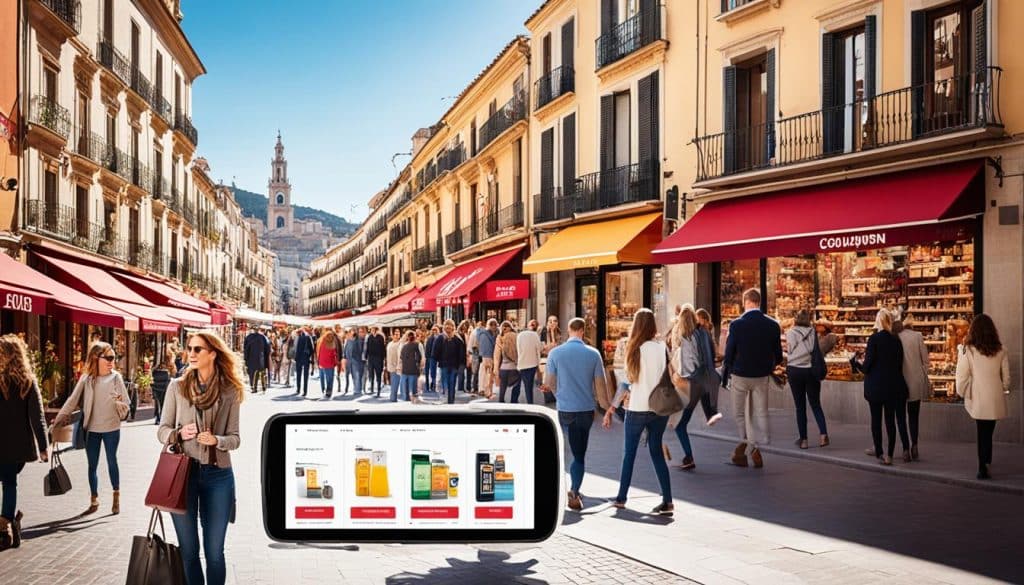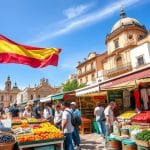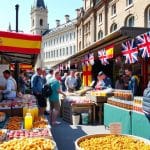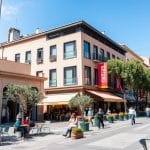The retail scene in Spain is changing a lot. New trends are making shopping different for people. It’s important to understand these changes in retail. In this article, we’ll look at the trends and shifts in the retail world, using data and insights from trusted sources.
Key Takeaways:
- The retail industry in Spain is experiencing significant changes and trends.
- Consumer preferences are shaping the retail landscape in Spain.
- Sustainability and the circular economy are becoming increasingly important to Spanish consumers.
- Offline retail is making a comeback in Spain, offering unique experiences to shoppers.
- The informal retail sector, including street vendors and local markets, is growing in popularity.
Retail in Spain: A Big Picture Overview
The retail industry in Spain is growing steadily, with the grocery market increasing by 7.6% in 2023. Modern trade is leading this growth, leaving traditional channels behind. Especially, supermarkets are becoming more popular and controlling a larger part of the market.
In 2023, five main supermarket chains dominate the scene. These are Mercadona, Carrefour, Lidl, Eroski Group, and DIA. Together, they make up more than half of all FMCG spending in the country. This shows how organised retail and supermarkets play a big role in Spain’s retail market.
| Supermarket Chain | Market Share |
|---|---|
| Mercadona | 32% |
| Carrefour | 14% |
| Lidl | 8% |
| Eroski Group | 5% |
| DIA | 4% |
The power of these top supermarket chains shows how much organized retail matters in Spain. It greatly influences what and how people buy.
The retail landscape in Spain is changing fast. Retailers need to keep up with new trends and customer needs to stay ahead.
Changing Consumer Preferences: Sustainability and Circular Economy
Sustainability and circular economy principles are now vital for consumers making buying choices. Spanish retailers are changing their ways to attract those who care for the environment. They’re focusing on being more sustainable.
Retailers are turning to eco-friendly packaging to lessen waste and environmental harm. By choosing sustainable packaging, they both meet consumer demands and cut down on plastic waste.
Another strategy is to push for recycling and lowering waste. Many shops offer recycling stations or rewards for returning packaging. This encourages shoppers to support a circular economy.
Retailers are also adding sustainable products to their shelves. They ensure these items come from ethical and green suppliers. This shows their commitment to protecting the planet.
The circular economy is getting more popular in retail too. Some shops now repair or repurpose goods to make them last longer. This reduces waste and offers customers greener options.
By adopting these green practices and joining the circular economy movement, Spanish retailers are showing their green stripes. They’re drawing in shoppers who value sustainability. This change is pushing retailers to adapt and offer greener shopping experiences.
Renewed Interest in Offline Retail
In Spain, there’s a new excitement around offline retail. Shoppers want shopping experiences that are unique and personal. This shift is bringing life back to physical stores. Retailers are enhancing the look and feel of their stores to attract shoppers.
Offline retail has several benefits that online can’t match. Being able to touch products, talk to store staff, and take items home immediately are key reasons people prefer store shopping. Also, physical stores offer a social side, letting people meet others in their community.
In response to modern shoppers, Spanish stores are changing. They are using technology like interactive displays and apps to make shopping offline better. This way, customers get the best of both shopping worlds.
Case Study: Zara’s In-Store Technology
Zara is leading in Spain by using tech to make shopping special. They have interactive mirrors in changing rooms. These mirrors let customers try different items without leaving. They also suggest outfit combos.
Also, Zara has self-checkouts and mobile payments. These make buying smoother and match what tech-savvy buyers want.
But it’s not just about technology. Stores aim to make shopping a memorable experience. They have events and workshops that turn shopping into an adventure. This makes offline shopping stand out.
The Future of Offline Retail in Spain
Even with online shopping growing, physical stores are still key in Spain. They offer experiences you can’t get online, which draws customers in. The blending of offline and online shops is shaping Spain’s retail future.
Retailers who adapt by using tech and offering immersive shopping will likely succeed. By mixing personal service with digital options, offline stores can meet the changing needs of shoppers.
| Retail Format | Advantages of Offline Retail in Spain |
|---|---|
| Traditional stores | – Unique and personalized shopping experiences – Ability to see and touch products – Interact with knowledgeable staff |
| Integrated offline and online retail | – Convenience and flexibility for customers – Seamless blend of digital and physical interactions – Research online, purchase offline |
| Experiential destinations | – Memorable and captivating environments – Opportunities for activities and events – Stronger connections with customers |
Informal Retail: A Growing Segment
Informal retail, like street vendors and local markets, is growing in Spain. They’re key to the local economy, offering unique products and experiences. Although formal retail is still on top, informal retail attracts people looking for different shopping experiences.
Street vendors are now common in Spanish cities. They sell everything from handmade items to street food. These vendors bring life and variety, drawing in both locals and tourists.
Local markets in Spain are flourishing too. They host a mix of vendors selling fresh produce to antiques. Shoppers can explore stalls, talk to sellers, and find special items not available in regular stores.
Informal retail stands out because of the personal connection between buyers and sellers. Sellers in street markets often know a lot about their products. They offer recommendations, share stories, and make shopping feel more personal and meaningful.
This sector is growing because consumers value authenticity and supporting local businesses. Informal retail offers a sense of community and a deeper look into local culture, unlike formal retail.
As more people choose informal retail, opportunities rise for small businesses and entrepreneurs. Yet, these retailers face legal challenges. Balancing growth with following regulations is crucial for authorities.
Changing Opening Hours for Physical Retail
The retail landscape in Spain is adapting to changing consumer lifestyles and preferences. This includes flexible opening hours. Retailers are extending their hours to provide more convenience and accessibility. This change caters to different customer needs, including those who shop in the evenings and on weekends.
By adjusting their hours, stores can match the busy lives of modern consumers. This offers a personalized shopping experience. Now, whether it’s for a late-night grocery run or weekend shopping, stores are open when customers need them.
This change shows retailers understand consumer habits better. They’re improving the shopping experience. By using technology and data, they can identify when people shop the most and adjust their hours to match.
Stores are not just extending their hours. Some now offer 24-hour access and self-checkout options. These changes help night owls and those with tight schedules. They make shopping more convenient for everyone.
Here’s an example of how opening hours have been extended in Spain:
| Retail Sector | Regular Opening Hours | Extended Opening Hours |
|---|---|---|
| Supermarkets | 8 am – 10 pm | 7 am – 12 am |
| Clothing Stores | 10 am – 8 pm | 9 am – 10 pm |
| Electronics Stores | 10 am – 9 pm | 9 am – 10 pm |
Extended hours benefit both customers and businesses. They allow retailers to boost sales and draw in more people. With these changes, Spanish retailers can stay ahead in a competitive market.
Seasonality: Impact on Retail Sales
In Spain, seasonal trends hugely influence retail sales all year. Shops use big holidays to boost their income. They lure buyers with special deals and discounts.
Christmas is eagerly awaited by Spanish retailers. Shoppers rush to buy gifts, decor, and holiday items. Stores offer great deals and a festive atmosphere, boosting sales significantly.
January is another key time for sales in Spain. After Christmas, people look forward to big discounts on many products. Shops offer great deals to drive sales, clear stock, and welcome new customers.
Summer sales are vital too. With the weather getting warmer, people buy new clothes, outdoor gear, and plan holidays. Shops use discounts and promotions to increase visits and spur buying.
Retailers in Spain work their marketing and stock to match these seasonal highs. By doing so, they can make the most of the sales opportunities these periods bring.
| Holiday Season | Total Retail Sales (in millions of euros) | Growth Compared to Previous Year |
|---|---|---|
| Christmas | 1,500 | +10% |
| January Sales | 800 | +5% |
| Summer Sales | 1,200 | +8% |
Supermarkets: Dominant Players in the Retail Market
Supermarkets are very important in Spain’s retail market. They offer a lot of products and make shopping easy. This has made them the first choice for many buyers. A few supermarket chains are really making a mark in terms of their size and impact.
Mercadona: Leading the Way
Mercadona is a big name in Spain’s supermarket scene. It has grown a lot and leads in market share. The chain has over 1,600 stores offering a variety of groceries and fresh items. They keep coming up with new ideas to address what consumers want.
Carrefour: a Global Retail Giant
Carrefour is known worldwide and has a big piece of Spain’s market. It’s famous for its wide range of products and good prices. The company has both hypermarkets and supermarkets, meeting the needs of all types of shoppers.
Lidl: Growing Presence and Competitive Prices
Lidl, from Germany, is becoming more known in Spain. Its good prices attract those looking to save money. Lidl is expanding its stores and focuses on making customers happy. This is helping it capture more of the market.
Eroski Group and DIA: Established Supermarket Chains
Eroski Group and DIA hold their own in Spain’s market. Eroski has many supermarkets and hypermarkets with a variety of products. DIA focuses on offering value through its large selection of groceries. These chains, including Mercadona, Carrefour, and Lidl, have a significant share of the grocery market in Spain. Their efforts to introduce new products and make shopping better have helped them stay ahead.
Market Share of Supermarkets in Spain (2023)
| Supermarket Chain | Market Share |
|---|---|
| Mercadona | 25% |
| Carrefour | 15% |
| Lidl | 10% |
| Eroski Group | 8% |
| DIA | 6% |
This table shows how big the major supermarkets are in Spain. Mercadona is at the top, followed by Carrefour, Lidl, Eroski Group, and DIA. It clearly shows which supermarkets are leading the market.
Hypermarkets and Discounters
In Spain, shoppers can choose between hypermarkets and discounters. Both options provide a wide variety of products at good prices. This makes them popular among consumers looking for value.
Leading Hypermarket: Carrefour
Carrefour is a top choice for hypermarket shopping in Spain. They care about sustainability and locally produced items. This focus attracts shoppers who prefer organic and local products.
Growing Presence of Discounters
Discounters like Lidl and Aldi are becoming more popular in Spain. They are opening more stores to reach more customers. Their growth is due to their commitment to quality products that are affordable.
These stores are known for their great deals and unique products. They offer discounted brand names and special items. This draws in customers who want to save money.
Stiff Competition and Consumer Benefits
The competition between hypermarkets and discounters benefits Spanish shoppers. It gives them access to various products at competitive prices. Stores offer sales, promotions, and loyalty rewards, improving the shopping experience.
These retailers also focus on making shopping convenient. They use technology to make the stores easy to navigate. Features like self-checkout save time for the customer.
Below is a table showcasing key information about Carrefour, Lidl, and Aldi, highlighting their strengths and market presence:
| Retailer | Strengths | Market Presence |
|---|---|---|
| Carrefour | Sustainability focus, local produce, organic products | Extensive presence across Spain |
| Lidl | Low prices, quality products, special offers | Expanding store network |
| Aldi | Competitive prices, exclusive ranges, efficient operations | Growing presence in Spain |
Carrefour, Lidl, and Aldi lead in Spain’s retail field. They focus on delivering value, quality, and sustainability. Their approaches to customer service keep them popular in the changing market.
Convenience Stores: Convenience and Expansion
Convenience stores have become vital in Spain’s changing retail landscape. Busy folks love them because they’re quick and handy. They offer lots of products and services, like click and collect or home delivery.
Spar shines brightly in Spain’s convenience retail scene. It has many stores in great spots. This helps Spar grab a big piece of the market.
Yet, Spain’s convenience retail world is super full. Stores can grow, but it’s hard. There’s a lot of competition and not much room for more stores.
Small Local Grocers: Challenges and Opportunities
Small local grocers in Spain have both hurdles and chances due to changing consumer likes. Bigger supermarkets lure shoppers with low prices and easy access. Yet, places like traditional bakeries and organic stores have found their special crowd. They focus on customers wanting something different and local, drawing in a steady group of shoppers.
One big struggle for these small shops is to match the prices and convenience of larger stores. Shoppers often look for cheaper options and the ease of getting everything in one place. But, more people now care about the environment and supporting community businesses. This is a chance for small grocers to showcase their quality products and commitment to sustainability. It attracts those who prefer to shop in a way that feels more ethical and personal.
Online selling is a way for small grocers to grow and face their challenges. By being online and offering services like delivery, they can reach more customers. Even those far away who like their unique products and personal service. This helps people who value what small grocers offer but can’t visit in person because of distance.
Offering ready meals and food services is another way for small grocers to bring in customers. People want quick meal solutions that are still tasty and high-quality. Small grocers can meet this need with ready-to-eat meals using local products. It’s a handy option for those who don’t have time to cook.
In the end, even with big competition, small local grocers in Spain can find ways to succeed. Focusing on what makes them different, using online sales, and offering new products helps them stay in the game. These strategies let them make their own space in the market.
General Merchandise Stores: The Influence of Inbound Tourism
General merchandise stores in Spain, like El Corte Inglés, are investing in the future. They see a big chance to attract tourists with a wide range of products. These stores aim to create shopping experiences that captivate.
El Corte Inglés is a top department store in Spain, beloved by locals and visitors. It offers everything from clothes and accessories to home goods and electronics. It keeps innovating to meet the changing needs of shoppers.
Capitalizing on the Influx of Tourists
The effect of tourism on these stores is huge. As Spain stays a top vacation spot, these stores aim to meet tourist needs.
They offer products for all kinds of customers. This means tourists find high-end items and affordable gifts. It helps stores catch a big part of the tourist spend.
This increase in tourists not only brings more people to the stores. It also opens chances for selling more. Tourists looking for unique local items tend to buy more than they planned.
Intensifying Competition in the General Merchandise Sector
As more tourists visit Spain, competition grows among merchandise stores. New players, like Pepco, want a share of the tourist market.
Pepco is a popular discount shop known for trendy, cheap clothes and accessories. It plans to open more stores in key tourist spots. Pepco wants to draw in locals and tourists with its good value.
This growing competition makes stores constantly innovate. They look for ways to stand out, like offering unique experiences or special deals. Retailers work hard to attract tourists with something different.
Conclusion
The retail world in Spain is changing fast, because of new customer likes and trends. Supermarkets are still top, with big names like Mercadona, Carrefour, and Lidl leading. These shops are changing their ways to keep and attract customers.
Street vendors and local markets are more popular now, offering special products and experiences. They help the local economy and give shoppers a different choice.
Stores are being made over, as people look for a shopping experience that’s personal and immersive. Traditional shops are coming back to life. Retailers are sprucing up stores to make shopping there special.
Sustainability, ease, and unique experiences are very important in Spain’s retail scene now. Shops are going green, selling eco-friendly products, and staying open longer to fit into busy lives.














